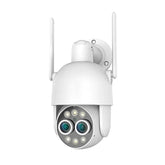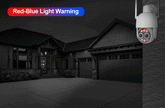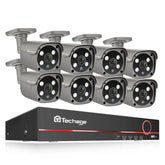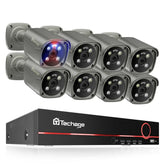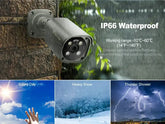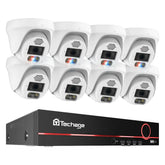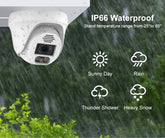A Comprehensive Overview of Video Recorders: From Analog to IP NVRs
Introduction:
Video recorders have been instrumental in capturing and preserving moments in history, entertainment, and security. Over time, these recording devices have evolved from analog to digital technology, culminating in the widespread adoption of IP NVRs (Network Video Recorders). This blog provides an in-depth exploration of video recorders, their evolutionary journey from analog to digital, and a breakdown of the three main types of IP NVRs: WiFi NVR, POE NVR, and 12V IP NVR. We will first examine their common characteristics before delving into their unique features.
What is a Video Recorder?
A video recorder, commonly known as a DVR (Digital Video Recorder) or NVR (Network Video Recorder), is an electronic device designed to capture, process, and store video footage from connected cameras. Video recorders serve a myriad of purposes, including security surveillance, entertainment recording, and video production.
The Evolution from Analog to Digital DVR and NVR:
The history of video recorders dates back to the 1950s when analog recording devices used magnetic tapes to store video signals captured by cameras. However, with the advent of digital technology, analog DVRs were eventually replaced by digital NVRs. Unlike their analog counterparts, digital NVRs process and compress digital video streams directly, leading to higher-quality video, efficient storage, and enhanced capabilities.
The Prevalence of IP NVRs:
Today, IP NVRs dominate the market, offering versatile and powerful solutions for video recording. IP NVRs work with IP cameras, which transmit digital video data over computer networks, enabling features like remote access and real-time monitoring. Three popular types of IP NVRs are WiFi NVR, POE NVR, and 12V IP NVR.
Similarities between WiFi NVR, POE NVR, and 12V IP NVR:
IP Camera Compatibility: All three types of NVRs are designed to be compatible with IP cameras, which transmit digital video data over computer networks.
Digital Video Processing: WiFi NVR, POE NVR, and normal IP NVRs process and store digital video streams, offering higher video quality and more efficient compression compared to analog video recorders.
Remote Access: Users can access live video feeds and recorded footage remotely through smartphones, tablets, or computers using dedicated applications or web interfaces, regardless of the NVR type.
Scalability: They all support multiple IP cameras, allowing users to expand the surveillance system as needed by adding additional cameras to the network.
Storage Options: All three types of NVRs enable users to store video footage on various storage devices, such as hard drives, network-attached storage (NAS) devices, or cloud-based solutions.
Video Management Software: They come equipped with video management software that allows users to configure camera settings, set recording schedules, and access playback options.
Event Triggering: WiFi NVR, POE NVR, and normal IP NVRs can be set up to trigger recording based on specific events, such as motion detection or external sensor inputs.
Compatibility with Network Protocols: They all support standard network protocols like TCP/IP, UDP, HTTP, and ONVIF, ensuring seamless communication between the NVR and IP cameras.
Security Features: These NVRs typically offer security features like user authentication, access control, and encryption to protect the video data from unauthorized access.
Integration with Security Systems: WiFi NVR, POE NVR, and normal IP NVRs can be integrated with other security systems, such as alarms and access control, to create comprehensive surveillance solutions.
Differences between WiFi NVR, POE NVR, and 12V IP NVR:
What is WiFi NVR (Wireless NVR)?
Wireless Connectivity: WiFi NVRs connect to IP cameras wirelessly, eliminating the need for physical cables between the NVR and cameras.
Power Supply: WiFi NVRs require separate power sources for each IP camera, as they do not deliver power through the wireless connection.
Installation Flexibility: WiFi NVRs offer greater flexibility in camera placement, making them suitable for locations where running cables might be challenging.
What is POE NVR (Power over Ethernet NVR)?
PoE Support: POE NVRs support Power over Ethernet, which means they can deliver both data and power to IP cameras through a single Ethernet cable.
Simplified Wiring: POE NVRs reduce cable clutter and simplify installation since only one cable is required to connect each camera.
Distance Limitation: POE NVRs are limited by the maximum distance a single Ethernet cable can transmit data and power, which may influence the placement of cameras.
What is 12V IP NVR?
Power Supply: 12V IP NVRs use a 12-volt power supply for both the NVR and connected IP cameras, requiring separate power cables for each camera.
Wiring Requirements: The need for separate power cables may result in more complex wiring installations compared to WiFi and POE NVRs.
Can Any IP Camera Work with Any NVR?
In general, IP cameras are designed to be compatible with various Network Video Recorders (NVRs) that adhere to standard protocols and specifications. However, there are certain considerations and requirements to keep in mind to ensure proper compatibility between an IP camera and an NVR:
Protocol Support: Both the IP camera and NVR must support the same network protocols, such as ONVIF (Open Network Video Interface Forum) or RTSP (Real-Time Streaming Protocol). These protocols allow for communication and video streaming between the camera and the NVR.
Resolution and Codec Compatibility: The NVR should support the resolution and video compression codec used by the IP camera. If the camera outputs video in a specific resolution or encoding format, the NVR must be capable of handling it to ensure seamless recording and playback.
Number of Channels: The NVR should have enough available channels to accommodate the number of IP cameras you intend to connect. Each camera typically requires a dedicated channel on the NVR for recording and management.
Power Requirements: Depending on the IP camera type (e.g., POE or non-POE), ensure that the NVR provides the necessary power supply for the cameras. POE (Power over Ethernet) NVRs can directly power compatible POE IP cameras through the same Ethernet cable used for data transmission, while non-POE cameras may require separate power supplies.
Network Bandwidth: Consider the available network bandwidth, especially if you plan to connect multiple high-resolution IP cameras to the NVR. Insufficient bandwidth may result in video quality issues or dropped frames during live viewing or recording.
Firmware Updates: Keep the firmware of both the IP camera and the NVR up to date to ensure compatibility and access to the latest features and improvements.
Brand Compatibility: While many IP cameras and NVRs are designed to be interoperable, it is always a good practice to check the compatibility list or documentation provided by the camera and NVR manufacturers to ensure they are explicitly listed as compatible with each other.
It's worth noting that some higher-end NVRs may be more flexible in supporting a wider range of IP cameras, including those from different manufacturers. However, to ensure seamless integration and optimal performance, it is recommended to use IP cameras and NVRs from the same brand or those explicitly stated as compatible by both manufacturers.
Nowadays, most surveillance brands have introduced their respective WiFi camera systems, POE camera systems, and some hybrid IP camera systems.
If you want to diy your own security camera system for small business or home, it's a good idea to consult with the manufacturer's documentation or support team to confirm compatibility and any specific requirements for the devices you intend to use.
Conclusion:
Video recorders have come a long way since the era of analog recording. Today, IP NVRs, including WiFi NVR, POE NVR, and 12V IP NVR, represent the cutting-edge technology for video surveillance and recording. While they share common features such as digital video processing and remote access, their unique characteristics cater to various installation scenarios and user preferences. As technology continues to evolve, video recorders will undoubtedly continue to advance, providing even more innovative solutions for video capture and storage needs.




